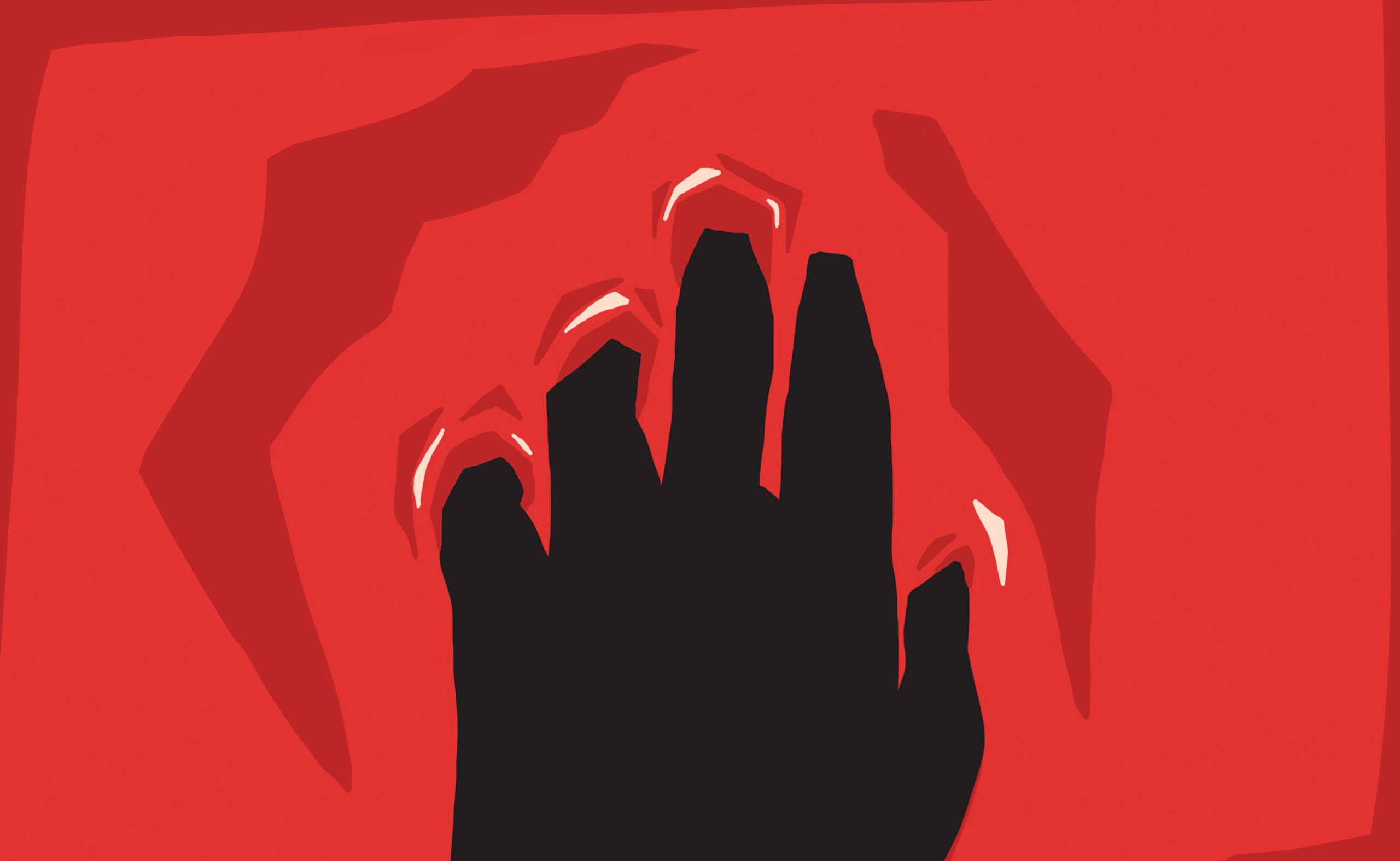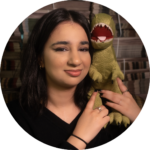Etch
And there it is. A cold piece of bone staring at her. So soft and small—she doesn’t know it is a child’s bone when she retrieves it from underneath her bed. Her muscles tense. She doesn’t know what to do; her hands itch to drop the decaying bone back to the ground and forget she ever saw it in the first place. But she can’t. How long has it been there? Horror and disgust boil inside her as she tries to ignore the numbness in her heart. Whose bone is it? A question she doesn’t want to answer, but an answer she already knows.
A wave of distress crashes into her, applying a rhythmic pressure inside her head. She’s drowning. Releasing the grip of her right hand from the bone, she squeezes the bridge of her nose, seeking relief from her immediate headache. She caresses the striations scattered across the bone with her left thumb as she tries to refocus her thoughts. Her mind settles on the various marks engraved on its exterior. Jagged cracks—large and small, deep and shallow—embellish its frail shape. As a printmaker, she knows how to read marks, to retrace an artist’s hand and their emotions within each swipe.
Most of the lines that scar the bone are sharp. As if assaulted by a blade, thin lines lightly kiss the surface, and deep, irregular cuts tear into the bone, leaving it vulnerable. She can feel it all—the spontaneity of the lines, the carelessness of the assaulter, and the desire to hurt. She can almost feel an absence in her body, dully pounding like a heartbeat in a papercut. Fighting the sudden need to sit down, wrap her arms around her legs, and cry. She isn’t ready.
Soon, the night sky engulfs the room, leaving the small square window at the end of her bed as her only source of light. She can’t see the entirety of the bone anymore; the moonlight shows only the contours of its form. The window is open, and the winter night pulls in cold air inside, making her shiver. Her sore feet beg her to sit down—she has been standing for hours. She lies on her bed, wrapped in a blanket, still holding onto the small bone. The cuts peek from underneath her fingertips as she traces them like the needle of a record player, a familiar song hums at the back of her mind. A gnawing feeling that she tries to suppress opens the void once more. Bottled up feelings fill the silence in the room, suffocating her. Escaping onto her fingers are stories and memories lost deep inside the crevasses of the bone marks. As she traces the scars on the bone one last time, she wishes to forget. She curls to the side like a fetus. Her arms cradling her body, prayed that her hard squeeze would turn the bone to dust. Nothing is real.
Sleep escapes her. Left awake and shivering under her blanket, the cold air tightens her skin, making it sensitive to the bone’s touch as it remains bound to her hands. The crevices try to indent her palms, but the lines aren’t strong enough, not deep enough to leave an impression on her rigid flesh. She can only feel a fragment of her memories from the surface touching her hands. The bone exposes an absence within her, mental and physical, that she can no longer ignore. A familiar pounding presence invades every thought and breath she takes. Her gritted teeth failing to force down the scream that licks her throat. There is no escape—even if she claws and tears her way out of her own skin.
The cold cartilage awakens frustration within her restless body. All she wants is sleep. She stumbles over to her desk at the corner of her room, its surface lined with pencil, paper, and plenty of inks. She grabs a pair of gloves, safety goggles, and a bandana hidden behind a pile of scrap paper and puts them on. The frosty air is much more piercing now that she stands in front of the window, but her face and hands are safe from the harsh winds blowing inside the room. She reaches underneath her desk for a bucket filled with a solution of diluted corrosive acid and removes the lid. She drops the bone into the acid, finally loosening the tension in her unfurling hand. The acid bites into the marks of the bone. The lines set deeper and deeper. All she can to do is wait—soon, there will be nothing.
Slow: the acid is slow, but time moves slower. She watches the window. Her quick, heavy breathing fogs up the goggles as the burning colours of red, orange, and yellow light up and devour the navy-blue sky. The chirping of birds accompanies the rising sun until no remnants of night is left. She should feel calm as the golden rays enter her room, but the warmth doesn’t penetrate her thoughts. She can’t stop thinking about the bone. Will she forget it existed once it fully disintegrates? Or will its absence create a hole in her mind of painful emptiness, forgotten but felt? Guilt bubbling in her stomach, she realizes she can’t destroy the bone; it is a piece of her that will forever consume her. Carefully, she removes the dissolving bone from the bucket. She walks over to the bathroom and toward the shower, avoiding her reflection in the mirror as she moves. She takes off her goggles. The showerhead rinses the excess acid off the bone’s surface. Under the bright white fluorescent lights, she can see the damage she has caused. She gets rid of her gloves, eager to feel the bone on her skin again.
Lines previously invisible become clear, and a threaded network of chaos with no beginning or end reveals itself on the surface. Overwhelmed by the number of marks left on the bone, she gently traces the lines as she did before. This time, they feel different. The acid has sharpened the edges of the crevices, creating cuts in her fingertips, deep enough to bleed. Her blood fills the voids, quickly trickling over the entire exterior. A sudden thought fills her mind—a beacon of freedom.
Back in her bedroom, she unravels an enormous roll of white paper onto the floor and sits on top of it. Wiping the excess blood off the bone, she lifts it over her head, gaining momentum to strike. Using all her bodily pressure to hold the paper still beneath her knees, she slams the bone into the ground to leave a mark, indenting the paper’s cotton fibers. She quickly lifts the bone away from the paper and observes the bright red web of lines imprinted. Finally, it has no power. She is in control.
–––
She’s done this before.
Submerge the bone in acid, wait, bleed, print. Over, and over, and over again. Until the crimson red doesn’t wash away, sinking into her skin. Years have passed since she found the bone, yet it remains in one piece. Abused through years of stress, beginning to deteriorate. It erodes, the lines blurring the more she prints. As she pushes it into the paper, she exerts more pressure, chipping away at the bone, adding more cracks and lines into its fading surface each time.
As she grazes her fingers over the battered cartilage, distorted voices flood her mind. Their sharp tongues echo a prophecy behind their teeth, tremors reaching her soul without them even uttering the words. Each syllable whips into her, breaking her and what she could become. Memories of their acidic words continue to bite into her as their voices become her own. The bone’s score is stuck in her head; she doesn’t know anything else.
Submerge the bone in acid, wait, bleed, print. Until everything makes sense. She is trapped by a past made of fading memories. Her past, present, and future blend into nothingness. Dragging her with it.
Again!
She clenches the bone until her knuckles go white, then slams it into the paper. Countless times, she has used her body as a printing press, using all her weight to push the bone into the paper, for it to absorb all her blood. Her body is breaking.
Submerge the bone in acid, wait, bleed, print. Until the bleeding stops. But she can barely stop the bleeding. She doesn’t have enough paper lining her bedroom floor, so she keeps layering the bone’s imprints one on top of the other. The small lamp on her nightstand provides enough light to see each additional print coat the dried brown blood into a glistening ruby. The lines she recorded years ago disappear into a sea of red.
She stops—there is nowhere else to print. Every inch of paper is drenched in blood. Her previous prints are gone, leaving only a bloody mess. All the time she lost to end up with nothing, alone with her thoughts. There is nothing more to add, nothing more to think. Her artwork is complete.
She hangs the paper on her white walls to see all the work she has put in through the years. Blood drips from the soaking wet paper onto the ground. For the first time, she sees what she’s done.
She is sticky all over from layers of blood and sweat. Her body heat dries up all the moisture and fuses it into her skin. She can’t move, the dried blood stiffens her flesh and traps her body. Fresh blood continues to drip down, trickling her left thigh and pooling around her feet. The floor wet with slithering mahogany substance, waits to greet her when she falls. The metallic air burns through her nose, clawing into her mouth. Her blood is everywhere—an endless void swallowing her whole.
Moving erratically inch-by-inch, the blood pulls and nips at her skin. But she continues to move forward. Soon, her blood-layered skin starts to flake by the friction caused from her repeated movements, exposing her pale tan flesh buried under all that sangria red. She steadily walks closer to the paper to inspect it; there must be a dry white spot somewhere. Hope simmering in her chest, she turns the lamp on to see every detail clearly. The glow bounces off the wet blood, making the surface shine on the wall. She stares into a reflection. It stares right back, looking blankly at her through dark brown eyes tinted in red, eyes that look like hers but are not her own.
How long has it been there? A presence she can’t recognize. “Who is she,” she thinks.
“No, who am I?”
Design Editor (Volume 49) | design@themedium.ca — Manjot graduated with a specialization in Art and Art History in 2022. She previously worked as the design editor for Volume 48. This year she will continue her role as design editor and looks forward to creating and sharing more art. As she navigates her newly graduated status, she spends her time designing, reading, and watching TV shows.


